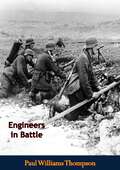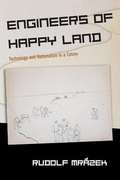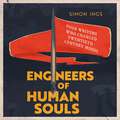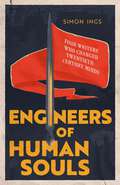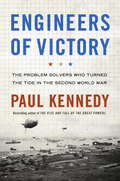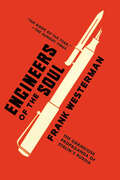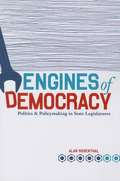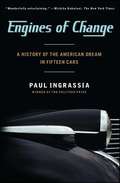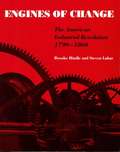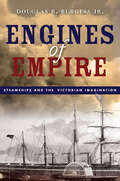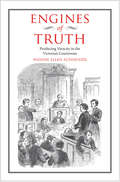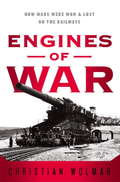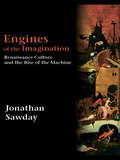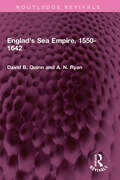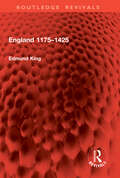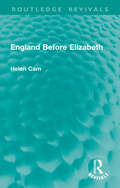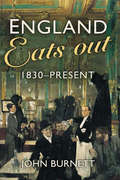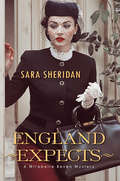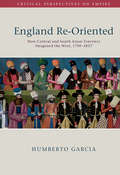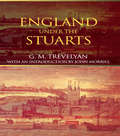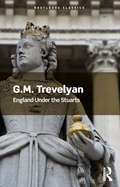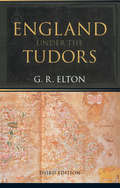- Table View
- List View
Engineers in Battle
by Paul Williams Thompson E. ReyboldMODERN war, in placing a premium on mobility, has placed a premium on the Engineer. For it is the task of the Engineer to keep the routes of advance clear of obstacles which might impede the progress of the modern engines of war. This purely offensive role of the Engineer is in addition to all his conventional duties such as effecting demolitions and maintaining routes of communication.But, even in his conventional dudes, the Engineer now proceeds with new equipment, new techniques, and new doctrines. It is literally true that one who knows only the Engineer unit of World War I would scarcely recognize the corresponding unit today.As America learns to know its new Army better and better, these facts will become self-evident. Meanwhile, for living examples of the modern conception of the Engineer in battle, one can do no better than go to the records of the actual engagements in Europe.Colonel Thompson’s book takes us to the European battlefields, and throws the spotlight on the actions of combat Engineers:…including Warsaw, Bzura, the Upper Rhine, the Maginot Line and others. He also looks at mine-laying operations and pontooneering on the Loire and Seine.
Engineers in Western Europe: A Profession Torn Between Technology and Economy, 1850–1990, with Outlooks to the Present
by Rolf TorstendahlIn his book, pending between history and sociology, on engineers in thirteen countries of the western part of Europe, Professor Rolf Torstendahl approaches the development from around 1850 up to the present situation from different angles. - One examines the educational patterns and the author shows how widely different types of formation of engineers existed in Britain, France and Germany in the early period. They were paradigmatic for other countries. Differences remain but patterns have gradually become similar. - From another angle the author makes professional organisations of engineers a main object of study, and they vary from alumni associations to powerful lobby organisations. - A third approach in the book is to examine engineers versus sociological theories of professionalism on the one hand and theories of managerialism on the other. In the last chapter the author also discusses topics like technocracy and the responsibility of engineers.
Engineers of Happy Land: Technology and Nationalism in a Colony
by Rudolf MrazekBased on close reading of historical documents--poetry as much as statistics--and focused on the conceptualization of technology, this book is an unconventional evocation of late colonial Netherlands East Indies (today Indonesia). In considering technology and the ways that people use and think about things, Rudolf Mrázek invents an original way to talk about freedom, colonialism, nationalism, literature, revolution, and human nature.
Engineers of Human Souls: Four Writers Who Changed Twentieth-Century Minds
by Simon IngsFour writers. Four dictators. One world, changed out of all recognition. ENGINEERS OF HUMAN SOULS is an intimate and shocking shadow history of creative vanity in a time that turned writers - once the faithful servants of authority - into figures of political consequence.Maurice Barrès, who first wielded the politics of identity. Gabriele D'Annunzio, whose poetry became a blueprint for fascism. Maxim Gorky, dramatist of the working class and Stalin's cheerleader. The Maoist Ding Ling, whose stories exculpated the regime that kept her imprisoned.All four nursed extravagant visions of the future, and believed they were vital to its realisation. Each was lured to the centre of political action. Each established a dangerous and damaging relationship with a notorious dictator. And when writers and rulers find a use for each other, the consequences can be shattering for us all. These stories - of courage and compromise, vanity and malevolence - speak urgently to the uncontrollable power of words.
Engineers of Human Souls: Four Writers Who Changed Twentieth-Century Minds
by Simon IngsFour writers. Four dictators. One world, changed out of all recognition. ENGINEERS OF HUMAN SOULS is an intimate and shocking shadow history of creative vanity in a time that turned writers - once the faithful servants of authority - into figures of political consequence.Maurice Barrès, who first wielded the politics of identity. Gabriele D'Annunzio, whose poetry became a blueprint for fascism. Maxim Gorky, dramatist of the working class and Stalin's cheerleader. The Maoist Ding Ling, whose stories exculpated the regime that kept her imprisoned.All four nursed extravagant visions of the future, and believed they were vital to its realisation. Each was lured to the centre of political action. Each established a dangerous and damaging relationship with a notorious dictator. And when writers and rulers find a use for each other, the consequences can be shattering for us all. These stories - of courage and compromise, vanity and malevolence - speak urgently to the uncontrollable power of words.
Engineers of Victory
by Paul KennedyPaul Kennedy, award-winning author of The Rise and Fall of the Great Powers and one of today's most renowned historians, now provides a new and unique look at how World War II was won. Engineers of Victory is a fascinating nuts-and-bolts account of the strategic factors that led to Allied victory. Kennedy reveals how the leaders' grand strategy was carried out by the ordinary soldiers, scientists, engineers, and businessmen responsible for realizing their commanders' visions of success.In January 1943, FDR and Churchill convened in Casablanca and established the Allied objectives for the war: to defeat the Nazi blitzkrieg; to control the Atlantic sea lanes and the air over western and central Europe; to take the fight to the European mainland; and to end Japan's imperialism. Astonishingly, a little over a year later, these ambitious goals had nearly all been accomplished. With riveting, tactical detail, Engineers of Victory reveals how.Kennedy recounts the inside stories of the invention of the cavity magnetron, a miniature radar "as small as a soup plate," and the Hedgehog, a multi-headed grenade launcher that allowed the Allies to overcome the threat to their convoys crossing the Atlantic; the critical decision by engineers to install a super-charged Rolls-Royce engine in the P-51 Mustang, creating a fighter plane more powerful than the Luftwaffe's; and the innovative use of pontoon bridges (made from rafts strung together) to help Russian troops cross rivers and elude the Nazi blitzkrieg. He takes readers behind the scenes, unveiling exactly how thousands of individual Allied planes and fighting ships were choreographed to collectively pull off the invasion of Normandy, and illuminating how crew chiefs perfected the high-flying and inaccessible B-29 Superfortress that would drop the atomic bombs on Japan.The story of World War II is often told as a grand narrative, as if it were fought by supermen or decided by fate. Here Kennedy uncovers the real heroes of the war, highlighting for the first time the creative strategies, tactics, and organizational decisions that made the lofty Allied objectives into a successful reality. In an even more significant way, Engineers of Victory has another claim to our attention, for it restores "the middle level of war" to its rightful place in history.Advance praise for Engineers of Victory "Paul Kennedy's history of World War II is a demonstration not only of incisive analysis and mastery of subject, but of profound integrity, and a historian's desire to celebrate not great leaders but the forgotten scientists, technicians, and logisticians who gave us the tactical edge, without which the strategic designs could never have been achieved."--Robert D. Kaplan, author of The Revenge of Geography "Kennedy's fine-grained analysis and suspicion of any one single cause--like cipher cracking, intelligence and deception operations, or specific weapons systems, like the Soviet T-34 tank--permit him to persuasively array his supporting facts. . . . An absorbing new approach to a well-worked field."--Kirkus Reviews (starred review) "A fresh and stimulating approach."--Publishers WeeklyFrom the Hardcover edition.
Engineers of the Soul: The Grandiose Propaganda of Stalin's Russia
by Frank WestermanA brilliant fusion of travel writing and Soviet history which reads like Bruce Chatwin. Engineers of the Soul is the riveting story of two journeys -- one literal, one imaginary -- through contemporary Russia and through Soviet-era literature. Travelling through present and past, Frank Westerman draws the reader into the wild euphoria of the Russian Revolution, as art and reality are bent to radically new purposes. Writers of renown, described by Stalin as 'engineers of the soul', were encouraged to sing the praises of canal and dam construction under titles such as Energy, The Hydraulic Power Station and Onward, Time! But their enthusiasm -- spontaneous and idealistic at first -- soon becomes an obligatory song of praise. And as these colossal waterworks lead to slavery and destruction, Soviet writers labour on in the service of a deluded totalitarian society. Combining investigative journalism with literary history, Westerman examines both the landscape of 'Oriental despotism' and the books -- and lives -- of writers caught in the wheels of the system. 'It is easy to die a hero's death,' wrote Konstantin Paustovsky, 'but it is difficult to live a hero's life. ' Engineers of the Soul sweeps the reader along to the dramatic dénouement: the final confrontation between writers and engineers that signalled the end of the Soviet empire.
Engines Of Democracy: Politics And Policymaking In State Legislatures
by Alan RosenthalState legislators have often been in the shadow of their national counterparts, but they drive the processes of democracy. Rosenthal brings together a lifetime of research and experience on state legislative politics into one eminently readable volume, Building on earlier work with new data and recent interviews and observations, Both a complement and contrast to the policymaking process on Capitol Hill, Engines of Democracy proves that no one gives insight into state legislators and their work the way Alan Rosenthal can.
Engines of Change: A History of the American Dream in Fifteen Cars
by Paul IngrassiaA narrative like no other: a cultural history that explores how cars have both propelled and reflected the American experience-- from the Model T to the Prius. From the assembly lines of Henry Ford to the open roads of Route 66, from the lore of Jack Kerouac to the sex appeal of the Hot Rod, America's history is a vehicular history--an idea brought brilliantly to life in this major work by Pulitzer Prize-winning journalist Paul Ingrassia. Ingrassia offers a wondrous epic in fifteen automobiles, including the Corvette, the Beetle, and the Chevy Corvair, as well as the personalities and tales behind them: Robert McNamara's unlikely role in Lee Iacocca's Mustang, John Z. DeLorean's Pontiac GTO , Henry Ford's Model T, as well as Honda's Accord, the BMW 3 Series, and the Jeep, among others. Through these cars and these characters, Ingrassia shows how the car has expressed the particularly American tension between the lure of freedom and the obligations of utility. He also takes us through the rise of American manufacturing, the suburbanization of the country, the birth of the hippie and the yuppie, the emancipation of women, and many more fateful episodes and eras, including the car's unintended consequences: trial lawyers, energy crises, and urban sprawl. Narrative history of the highest caliber, Engines of Change is an entirely edifying new way to look at the American story.
Engines of Change: The American Industrial Revolution 1790-1860
by Brooke Hindle Steven LubarTHE MATERIAL ASPECTS OF AMERICAN LIFE UNDERWENT GREAT CHANGE in the period from 1790 to 1860, a pattern of development often referred to as the American Industrial Revolution. At the center of this transformation was a series of technological developments that were directly associated with labor, management, and organizational change. This book's discussion begins with physical survivals of technologies of that era, most of them preserved in the Smithsonian Institution. The book, like the exhibition from which it is derived (also entitled Engines of Change), endeavors to look through these artifacts to gain an understanding of the Industrial Revolution that differs significantly from popular perceptions. Specific insights can be gained from three dimensional survivals and from two dimensional views that are neither available in written accounts nor communicable through words alone. The photographs, drawings, and maps included here are, consequently, more than mere illustrations, more than a pleasant way to underline the written text. Indeed, in some ways they constitute the book's primary message. At the same time, the most obvious message conveyed by artifacts and pictures is limited by its unavoidable specificity. It must always be placed in a larger and broader context. Occasionally, observers bring enough context with them to interpret the artifacts they see, but usually extended verbal explanation is required to make objects and pictures truly meaningful. That is the purpose of the text of this book- to provide the context, to look through the physical survivals to an enriched comprehension of the technology and related aspects of the American Industrial Revolution.
Engines of Empire: Steamships and the Victorian Imagination
by Douglas BurgessIn 1859, the S.S. Great Eastern departed from England on her maiden voyage. She was a remarkable wonder of the nineteenth century: an iron city longer than Trafalgar Square, taller than Big Ben's tower, heavier than Westminster Cathedral. Her paddles were the size of Ferris wheels; her decks could hold four thousand passengers bound for America, or ten thousand troops bound for the Raj. Yet she ended her days as a floating carnival before being unceremoniously dismantled in 1889. Steamships like the Great Eastern occupied a singular place in the Victorian mind. Crossing oceans, ferrying tourists and troops alike, they became emblems of nationalism, modernity, and humankind's triumph over the cruel elements. Throughout the nineteenth century, the spectacle of a ship's launch was one of the most recognizable symbols of British social and technological progress. Yet this celebration of the power of the empire masked overconfidence and an almost religious veneration of technology. Equating steam with civilization had catastrophic consequences for subjugated peoples around the world. Engines of Empire tells the story of the complex relationship between Victorians and their wondrous steamships, following famous travelers like Mark Twain, Charles Dickens, and Jules Verne as well as ordinary spectators, tourists, and imperial administrators as they cross oceans bound for the colonies. Rich with anecdotes and wry humor, it is a fascinating glimpse into a world where an empire felt powerful and anything seemed possible--if there was an engine behind it.
Engines of Truth
by Wendie Ellen SchneiderDuring the Victorian era, new laws allowed more witnesses to testify in court cases. At the same time, an emerging cultural emphasis on truth-telling drove the development of new ways of inhibiting perjury. Strikingly original and drawing on a broad array of archival research, Wendie Schneider's examination of the Victorian courtroom charts this period of experimentation and how its innovations shaped contemporary trial procedure. Blending legal, social, and colonial history, she shines new light on cross-examination, the most enduring product of this time and the "greatest legal engine ever invented for the discovery of truth. "
Engines of War: How Wars Were Won & Lost on the Railways
by Christian WolmarBefore the nineteenth century, armies had to rely on slow and unreliable methods of transportation to move soldiers and equipment during times of conflict. But with the birth of the railroad in the early 1830s, the way wars were fought would change forever. In Engines of War, renowned expert Christian Wolmar tells the story of that transformation, examining all the engagements in which railways played a part from the Crimean War and American Civil War through both world wars, the Korean War, and the Cold War with its mysterious missile trains. He shows that the 'iron road' not only made armies far more mobile, but also greatly increased the scale and power of available weaponry. Wars began to be fought across wider fronts and over longer timescales, with far deadlier consequences. From armored engines with their swiveling guns to track sabotage by way of dynamite, railway lines constructed across frozen Siberian lakes and a Boer war ambush involving Winston Churchill, Engines of War shows how the railways - a fantastic generator of wealth in peacetime - became a weapon of war exploited to the full by governments across the world.
Engines of the Imagination: Renaissance Culture and the Rise of the Machine
by Jonathan SawdayAt what point did machines and technology begin to have an impact on the cultural consciousness and imagination of Europe? How was this reflected through the art and literature of the time? Was technology a sign of the fall of humanity from its original state of innocence or a sign of human progress and mastery over the natural world? In his characteristically lucid and captivating style, Jonathan Sawday investigates these questions and more by engaging with the poetry, philosophy, art, and engineering of the period to find the lost world of the machine in the pre-industrial culture of the European Renaissance. The aesthetic and intellectual dimension of these machines appealed to familiar figures such as Shakespeare, Francis Bacon, Montaigne, and Leonardo da Vinci as well as to a host of lesser known writers and artists in the sixteenth and seventeenth centuries. This intellectual engagement with machines in the European Renaissance gave rise to new attitudes towards gender, work and labour, and even fostered the new sciences of artificial life and reason which would be pursued by figures such as Descartes, Hobbes, and Leibniz in the seventeenth century. Writers, philosophers and artists had mixed and often conflicting reactions to technology, reflecting a paradoxical attitude between modern progress and traditional values. Underpinning the enthusiastic creation of a machine-driven world, then, were stories of loss and catastrophe. These contradictory attitudes are part of the legacy of the European Renaissance, just as much as the plays of Shakespeare or the poetry of John Milton. And this historical legacy helps to explain many of our own attitudes towards the technology that surrounds us, sustains us, and sometimes perplexes us in the modern world.
Engines: The Inner Workings of Machines That Move the World
by Theodore GrayThe international bestselling author of How Things Work and The Elements Trilogy turns his focus to a visual exploration of the inner workings and functionality of the marvelous machines that run our world—from the first steam engines to giant turbines to today's tiny electrical engines. In Engines, the always entertaining and informative Theodore Gray explores the glorious guts and intricate innards of dozens of impressive machines. Through his engaging and unexpected stories and Nick Mann&’s trademark gorgeous photography, Gray takes us on a journey from ancient Greek steam engines to our most sophisticated twenty-first-century machinery. We take time to appreciate the detailed functionality of the internal combustion engine, the connection between magnetism and electric motors, as well as hydraulics, robotics, and more. Each chapter builds on the previous, illuminating the evolution of engines and revealing the ingenuity brought to bear as humans invented and perfected these marvelous mechanical systems. Along the way, Gray regales us with tales of his own experiences working with and collecting these machines. For fans of how things are made and how they work, Engines is a loving tribute to the mechanical world.
Englad's Sea Empire, 1550-1642 (Routledge Revivals)
by David B. Quinn A N RyanFirst published in 1983, England’s Sea Empire was originally part of the Early Modern Europe Today book series. It explores the relationships between the increase of English merchant shipping, the growth of naval power and the early experiments in overseas trade and colonisation. No other book combines these topics for the period from the middle of the 16th to the middle of the 17th century. In dealing with economic, strategic and technical problems, the authors write in language which is intelligible to non-specialist readers. They illustrate the arguments with generous quotations from contemporary sources and with maps of the regions under discussion. This book will be of value on undergraduate courses in early British or colonial or maritime history.
England (Enchantment of the World)
by Jean BlashfieldDescribes the geography history culture industry and people of England
England 1175–1425 (Routledge Revivals)
by Edmund KingDuring the years 1175–1425, English society developed in many ways. First published in 1979, England 1175–1425 offers an ideal introduction to the period, presenting as it does a view of a whole society that is derived from a study of economic, social, political, and administrative history. It argues that the later Middle Ages in England saw the creation of a single, integrated society, with a national economy and a national political consciousness, and it shows how this integration came about.The foundations of a unified community are seen in chapters on settlement, on lordship and on the world of ideas, while the development of this community is seen in chapters on political and social themes. The author describes how parliament became the political focus of the nation and stresses the importance of warfare and war taxation in this development. Original features of the book are the integration into a general survey of work on medieval archaeology, and a chapter on ideas which uses a wide range of material to present a picture of the attitudes which governed men’s lives. The Peasants’ Revolt of 1381 demonstrates especially clearly the argument that all classes of society shared similar ideas, and the episode is examined in detail.There is an emphasis throughout on quotations from original sources and these, together with the illustrative matter provide a clear picture of a society in a period of change.
England Before Elizabeth (Routledge Revivals)
by Helen CamOriginally published in 1950 and as a third edition in 1967, this volume traces the evolution of the English nation – the amalgamation of differing races and the unification of warring tribal princedoms into one monarchy under the stress of competition for power, the disciplinary influence of Christianity, the stimulus of foreign invasion, the compression of conquest, the centralisation of government, the standardisation of institutions, the interchange of trade, and the triumph of one common tongue in the rivalry of languages and dialects.
England Eats Out: A Social History of Eating Out in England from 1830 to the Present
by John BurnettWhy do so many people now eat out in England? Food and the culture surrounding how we consume it are high on everyone’s agenda. England Eats Out is the ultimate book for a nation obsessed with food. Today eating out is more than just getting fed; it is an expression of lifestyle. In the past it has been crucial to survival for the impoverished but a primary form of entertainment for the few. In the past, to eat outside the home for pleasure was mainly restricted to the wealthier classes when travelling or on holiday- there were clubs and pubs for men, but women did not normally eat in public places. Eating out came to all classes, to men, women and young people after World War Two as a result of rising standards of living, the growth of leisure and the emergence of new types of restaurants having wide popular appeal. England Eats Out explores these trends from the early nineteenth century to the present.From chop-houses and railway food to haute cuisine, award winning author John Burnett takes the reader on a gastronomic tour of 170 years of eating out, covering food for princes and paupers. Beautifully illustrated, England Eats Out covers highly topical subjects such as the history of fast food; the rise of the celebrity chef and the fascinating history of teashops, coffee houses, feasts and picnics.
England Expects: A Mirabelle Bevan Mystery: Book 3 (A Mirabelle Bevan Mystery #3)
by Sara SheridanDangers abound in 1950s Brighton as former Secret Service operative Mirabelle Bevan cuts to the chase to solve multiple murders . . . When sportswriter Joey Gillingham stops off at a Brighton barbershop for a shave and a trim, he gets more than he bargained for—a slashed throat. The journalist's next headline story in the paper is his obituary. With the ghastly murder the talk of the seaside town, Mirabelle and her close friend and coworker Vesta Churchill find themselves irresistibly drawn to the case. Rumors of the newspaperman being a member of the freemasons lead the ladies to the group’s local lodge, where they happen upon a cleaning lady in the throes of poisoning. Are the two deaths related? The common thread seems to connect to the secret society. Despite being warned off by Superintendent McGregor, the fearless friends continue to investigate, breaking into an abandoned royal residence in Brighton and following a trail of clues to a Cambridge college and bizarre masonic rituals. To beard the lion in his own den, Mirabelle and Vesta will need to walk the razor's edge—but with desperate characters and more bodies turning up, it's going to be a close shave . . .
England Re-Oriented: How Central and South Asian Travelers Imagined the West, 1750–1857 (Critical Perspectives on Empire)
by Humberto GarciaWhat does the love between British imperialists and their Asian partners reveal about orientalism's social origins? To answer this question, Humberto Garcia focuses on westward-bound Central and South Asian travel writers who have long been forgotten or dismissed by scholars. This bias has obscured how Joseph Emin, Sake Dean Mahomet, Sheikh I'tesamuddin, Abu Taleb Khan, Abul Hasan Khan, Yusuf Khan Kambalposh, and Lutfullah Khan found in their conviviality with Englishwomen and men a strategy for inhabiting a critical agency that appropriated various media to make Europe commensurate with Asia. Drama, dance, masquerades, visual art, museum exhibits, music, postal letters, and newsprint inspired these genteel men to recalibrate Persianate ways of behaving and knowing. Their cosmopolitanisms offer a unique window on an enchanted third space between empires in which Europe was peripheral to Islamic Indo-Eurasia. Their queer intimacies encrypt a mediated history of orientalist mimic men under the spell of a powerful Persian manhood.
England Under the Stuarts
by G. M. TrevelyanAn undisputed classic, England Under the Stuarts is an account of England in the years between 1603 and 1714, charting England's progress from a 'great nation' to a 'great empire'. G. M. Trevelyan's masterful narrative explores the major events of this period, which witnessed the upheavals of Civil War, the Restoration and the Glorious Revolution. While never neglecting to examine the conditions of English life, this celebrated historian highlights the liberty and toleration that emerged during these years. Almost a century after its first publication, and now with a new introduction by John Morrill, Trevelyan's thorough survey of the Stuart age remains certain to inform and delight anybody with an interest in this period of English history.
England Under the Stuarts (Routledge Classics)
by G. M. Trevelyan'While Germany boasts her Reformation and France her Revolution, England can point to her dealings with the House of Stuart.' - G.M. Trevelyan, from the Introduction England Under the Stuarts is an outstanding and highly engaging account of English history in the years between 1603 and 1714, charting England's path from nation to empire. G. M. Trevelyan's masterful narrative explores the major events of this period, which witnessed the upheavals of the Civil War, the Restoration and the Glorious Revolution. While never neglecting to examine the social, economic and religious conditions of English life, Trevelyan highlights the epic struggle between the threats of absolutism and despotism and the staunch political liberty and toleration that emerged during these years. He also gives the reader a vivid sense of what it was like to be there at the time, conveying a rich and dramatic flavour of events. As such, England Under the Stuarts remains certain to inform and delight anybody with an interest in this period of English history. This Routledge Classics edition includes a new Foreword by Peter Gaunt.
England Under the Tudors
by G. R. EltonFirst published in 1955 and never out of print, this wonderfully written text by one of the great historians of the twentieth century has guided generations of students through the turbulent history of Tudor England. Now in its third edition, England Under the Tudors charts a historical period that saw some monumental changes in religion, monarchy, government and the arts. Elton's classic and highly readable introduction to the Tudor period offers an essential source of information from the start of Henry VII's reign to the death of Elizabeth I.
